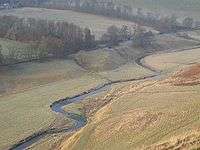Lyne Water
The Lyne Water is a tributary of the River Tweed which rises in the Pentland Hills of southern Scotland at Baddinsgill Reservoir. It runs through West Linton and Romannobridge, passes Flemington and Lyne Station and enters the Tweed west of Peebles. It floods regularly in winter and occasionally in summer. There is free fishing above Flemington Bridge, and below Flemington the river is part of the Peebles fishing authority.

Lyne Water
Etymology
The name Lyne was recorded first as Lyn in around 1190,[1] and is of Brittonic origin.[1] Unlike most rivers named Lyne, it is derived from lïnn, generally meaning "a pool" (Welsh llyn).[1]
gollark: I see.
gollark: Every screen frame? 60Hz typically?
gollark: Does SDL not have some "do this every frame" callback?
gollark: No.
gollark: Surely it should just draw the buffer to the screen every frame.
See also
References
- James, Alan G. "A Guide to the Place-Name Evidence - Guide to the Elements" (PDF). Scottish Place Name Society - The common Brittonic Language in the Old North. Retrieved 25 October 2018.
External links
| Wikimedia Commons has media related to Lyne Water. |
- RCAHMS: Border Union Railway, River Lyne Bridge to Harker Section
- Historic Environment Scotland. "Ledbeg River Chambered Cairn (4642)". Canmore.
- SCRAN: View of West Linton from the ford of the River Lyne (West Linton Historical Association)
- Roman fort, fortlet and camps at Hallyne, Lyne
- Lyne Farm
This article is issued from Wikipedia. The text is licensed under Creative Commons - Attribution - Sharealike. Additional terms may apply for the media files.